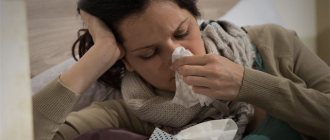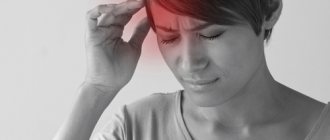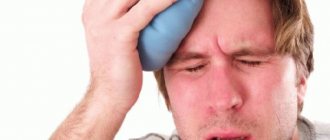There are about 200 known causes of headaches (cephalalgia). This may be an increase or decrease in blood pressure, pathology of cerebral vessels, diseases of the spine, brain vessels, brain tumors, intoxication. At the Yusupov Hospital, neurologists find out the cause of headaches using the latest diagnostic equipment from the world's leading manufacturers.
Headaches in the forehead can bother a patient with sinusitis or frontal sinusitis. In this case, treatment is carried out by otolaryngologists. If the cause of the headache is arterial hypertension, cardiologists provide antihypertensive therapy. In the presence of intoxication, infectious disease specialists treat patients with headaches. A multidisciplinary approach to the treatment of patients suffering from headaches can quickly improve the patient's condition.
Causes of headaches in women
When developing tactics for managing a patient with headache, neurologists at the Yusupov Hospital take into account its cause. Doctors relieve headaches with analgesics and at the same time treat the disease that caused this syndrome. Most often, headaches in women occur for the following reasons:
- Hormonal imbalances;
- Acute or chronic stress;
- Increase or decrease in blood pressure;
- Dysfunction of the autonomic nervous system;
- Diabetes mellitus;
- Infectious diseases (meningitis, encephalitis, tuberculosis);
- Inflammation of the neck muscles:
- Osteochondrosis of the cervical spine;
- Volumetric formations of the brain.
Treatment at the Energy of Health clinic
Even a mild headache can affect lifestyle and be a symptom of serious illnesses. Doctors at the Energy of Health clinic invite you to undergo a comprehensive examination and identify the cause of the discomfort. We offer modern, combined treatment methods, including:
- drug therapy according to indications;
- various types of physiotherapy;
- group and individual physical therapy classes, compiling sets of home exercises;
- therapeutic and general massage;
- manual therapy and osteopathic services if necessary;
- therapeutic procedures for sinusitis and other diseases of the ENT organs;
- ophthalmological care, etc.
Working together with the patient, we will find the cause of the pain and try to eliminate it as quickly as possible.
Causes of headaches in men
Men are most often bothered by cluster pain. It is localized in the temple area and the eyeball. Pain of varying intensity in men occurs during a respiratory disease, an infectious lesion of the body, after an injury, or during the development of a brain tumor. Headaches localized in the back of the head occur with arterial hypertension, stroke, and traumatic brain injury. Often men experience severe headaches accompanied by nosebleeds. The reasons for the violation may be:
- Diseases of the circulatory system;
- Failure of endocrine organs;
- Cardiovascular diseases;
- Meningitis.
- Stroke;
- Tumors of the brain or nasal cavity;
- Hypertension;
- Overwork.
Expert opinion
Author:
Tatyana Aleksandrovna Kosova
Head of the Department of Rehabilitation Medicine, neurologist, reflexologist
90% of the population has experienced headache symptoms at least once in their life. Such data is provided by the World Health Organization. In 20% of cases, the headache is permanent. The ratio in the morbidity structure among men and women is 1:3. Neurologists identify various causes of headaches. The most common etiological factors are migraine and tension headache. Migraine is diagnosed in 20–30% of cases, and tension headaches account for 50–70%.
A headache can be a symptom of a serious illness. Therefore, if a pathological sign appears frequently, as well as in the presence of other symptoms, you should consult a doctor. At the Yusupov Hospital, neurologists pay close attention to the treatment of various types of headaches. Diagnosis of possible causes is carried out using x-rays, MRI, CT, EEG, angiography and laboratory tests. If necessary, additional studies are prescribed. Individually selected therapy allows you to stop an acute attack and prevent the re-development of the pathological symptom. The drugs used are verified for quality and safety. Treatment regimens comply with international recommendations for headache therapy.
Condition classification
It is worth defining the main types of headaches. So, these include:
- Migraine. It manifests itself as severe pain, which is accompanied by nausea, weakness, as well as a negative reaction to strong odors and bright light. Often the pain is localized on one side. The attack can last several hours, and in severe cases, days. The condition is common among young women.
- Tension headache. It is also called tension. It is considered the most common. This pain is not very severe, but attacks can continue and recur for a week. The pain is compressive in nature and spreads to one or more areas of the head. It often develops in people who work under intense muscle loads, both dynamic and static. For example, people who work at a computer or drive a car are susceptible to such attacks.
- Cluster headache. It is also called Horton's. It is considered the most severe type of pain. In this condition, a person suffers prolonged attacks, and the pain itself is pulsating in nature, often localized on one side. This pain may be accompanied by hyperemia, swelling, and lacrimation. The duration of attacks ranges from twenty minutes to one and a half hours. Severe cases of the pathology can provoke several attacks a day for weeks. This condition is most often observed among young men.
- Headache caused by infectious diseases. In addition to ordinary respiratory pathologies, this type of pain can be caused by severe infections such as meningitis and encephalitis. Uncomplicated infections are accompanied by fever, chills, and pain is localized in the temporal and frontal regions. Patients also experience weakness, coughing, sneezing, and watery eyes. If meningitis is observed, the condition includes vomiting. The patient in this case needs immediate hospitalization.
- Post-traumatic pain syndrome. It is provoked by bruises, concussions, violations of the integrity of the bones of the skull and spinal column. In this case, the severity and nature of the painful sensations are determined by the type of traumatic injury.
- Sinus headache. It manifests itself as a result of an inflammatory process that often affects the paranasal sinuses. The condition also includes swelling of the mucous lining, nasal congestion, sneezing, and runny nose. Pain is detected in the frontal region and the area near the nose.
- Headache with increased intracranial pressure. The severity of the sensations is strong, nausea and light intolerance are often possible. It should be noted that in this case the pain is localized over the entire surface of the head and has a bursting, pressing character.
- Headaches due to damage to the trigeminal nerve. They last for seconds, but bring very unpleasant sensations. Pain can appear anywhere on the face when talking or eating. It is often provoked due to stomatitis, caries, malocclusion, and sinusitis.
Kinds
Neurologists distinguish the following types of headaches:
- Migraine – caused by a disruption of the vascular system;
- Tension headache - mainly occurs due to excessive tension in the neck, eye muscles, as well as the muscles of the shoulder girdle and scalp aponeurosis, as well as due to chronic stress, depression;
- Chronic paroxysmal hemicrania, cluster headache - can be primary or secondary.
- Headache not associated with damage to brain structures;
- Ambus headache that occurs when taking medications uncontrolled.
There are also headaches after traumatic brain injury, with diseases of the vascular system, and those that occur with intracranial disorders of extravascular origin.
Tensor headaches often occur in women after stress or nervous shock. It goes away in the presence of positive emotions, after drinking soothing herbal teas.
Neurologists do not recommend taking headache pills on your own. Each drug is designed to relieve a specific type of pain and has a number of contraindications. The doctor takes all this into account when prescribing a medicine to a patient.
Make an appointment
Migraine
Migraine is the most common type of headache.
It most often occurs in women from the onset of puberty (from 11-13 years) to 35 years. Migraine can be simple or with an aura. It can occur in the temple, crown, back of the head, and forehead. The cause of the disease is a hereditary disorder of vasomotor regulation of arteries located outside and inside the cranium. With migraines, headaches occur in the form of attacks. They bother you at varying frequencies - from once a week to once a year. The attack lasts from several hours to 3 days. Usually the pain is throbbing and covers half of the head. It often occurs after physical activity, stress, lack of sleep or too much sleep, or eating certain foods. A migraine attack is accompanied by nausea and vomiting, intolerance to bright light, noise, and strong odors. Sometimes the headache is very severe and lasts for several days - this condition is called status migraine. According to statistics, migraine occurs in 2% of people.
Neurologists believe that a migraine attack develops under the influence of the following provoking factors:
- Chronic stress;
- Overwork;
- Intense mental work;
- Hormonal disorders.
Often the cause of migraine is a family history.
Tension headache
This type of headache occurs as a result of prolonged tension in the muscles of the head and neck.
Tension headaches can be chronic and bother you constantly, only sometimes stopping for 2-3 days. There are no other violations. There is no nausea or vomiting, bright lights and loud noise do not cause suffering. Almost all sick people lead a normal life and have normal performance. Tension headaches often affect people with increased anxiety and a tendency to become depressed. Pain often occurs against the background of severe stress. There is a feeling of pressure on the top of the head or compression of the entire head. Many people suffering from this disorder take a lot of painkillers on a regular basis. Over time, this “treatment” can itself lead to headaches. Tension headaches are treated with antidepressants - only a doctor can prescribe them. Head massage and acupuncture help improve the condition.
Treatment
The doctor in our clinic, after the patient has undergone all the necessary types of research, based on their results, makes a conclusion about the presence of the disease and prescribes the correct treatment. Often, a neurologist deals with the treatment of headaches, but in certain cases, assistance from a specialist of other profiles may be required. You should not try to treat severe, persistent headaches on your own; this can only worsen the condition. It is important to contact the specialists of our clinic in time, who will help identify the pathology and eliminate its etiological factors and symptoms. Correct treatment will help get rid of the problem and prevent its recurrence.
In the eye and forehead area
Headaches in the forehead area are caused by various factors.
Cluster or beam pain occurs in the eye area. She may return after a while. Sometimes attacks continue for several hours. A headache that radiates to the eyeball can be a sign of migraine, eye diseases, brain tumors, and neurological diseases of the brain. It often occurs after severe or prolonged stress. The cause of the headache may be inflammation of the maxillary or frontal sinuses. It often radiates into the eyeballs. Sinus headache disappears after the underlying disease is cured. Pain in the forehead is a common symptom of meningitis, malaria, typhoid, and pneumonia.
In the occipital region of the head
In the back of the head, cephalgia occurs when blood pressure increases, the cause of which is osteochondrosis, spondylosis, spondylolisthesis, anomalies in the development of blood vessels in the head or neck.
Severe pain in the back of the head occurs after nervous strain, as a result of spasm of the neck muscles, arteries of the head and neck, and disruption of the outflow of venous blood from the head. It worries patients suffering from occipital neuralgia, vertebrobasilar insufficiency, spinal diseases, and migraines. A sharp headache in the back of the head often occurs with the development of a hypertensive crisis. Sharp, bursting, pulsating headaches in the back of the head are accompanied by pallor of the patient’s face, generalized hyperhidrosis, dry mouth, heart pain and tachycardia.
Chronic arterial hypertension with a slight increase in blood pressure is also characterized by the development of pain mainly in the occipital part of the head. The headache bothers the patient immediately after waking up, intensifies with physical activity, and is often accompanied by swelling of the lower eyelids. Pain is caused by a violation of the outflow of venous blood from the vessels of the head.
Combined with nausea
Severe headache and nausea are signs of migraine, meningitis, and hypertensive crisis.
Often the cause of these symptoms is sinusitis, sinusitis, or intoxication of the body. Nausea, headache, and dizziness are also symptoms of traumatic brain injury and infectious diseases. Patients complain of headache, nausea, weakness at the initial stage of influenza and acute respiratory infection. In this case, the body temperature rises to high numbers. The development of a migraine can be signaled by ripples in the eyes, nausea and headache. With a migraine, the patient's appetite disappears, an aversion to strong odors appears, nausea, irritability, photophobia, and numbness in certain parts of the body occur.
Headache and dizziness also occur when wearing incorrectly selected glasses or lenses or disruption of the vascular system. Headaches and spots in the eyes appear due to fatigue and nervous exhaustion, during weather changes, after stress. These symptoms occur in people who have suffered a traumatic brain injury, spinal injury or disease.
Headache and flashing spots before the eyes appear during a hypertensive crisis. Its variety - hyperkinetic crisis - begins abruptly with headache, nausea, flickering of spots before the eyes and vomiting. The patient feels hot. His sweating and heart rate increase. Trembling is felt throughout the whole body. High blood pressure can cause hypertensive encephalopathy. It manifests itself with the following symptoms:
- Very severe headache;
- Dizziness;
- Nausea;
- Vomiting;
- The flickering of flies in the eyes.
The patient may lose consciousness and die if medical care is not provided in a timely manner.
Headaches that occur in the morning after sleep can be a manifestation of a brain tumor, abusive cephalalgia, tension pain, or migraine. Overuse headache occurs with long-term use of analgesics. It gets worse in the morning. The intensity of the pain constantly changes throughout the day. Overuse headaches are aggravated by stress, mental tension, excessive physical activity, and also by stopping a drug that relieves pain. Abuse cephalgia becomes permanent if the patient suffers from depressive syndrome, is often irritated, and is very tired. Due to constant headaches, a person’s concentration and performance decrease. He sleeps poorly and constantly feels tired.
29.07.2019
“Hoop” of tension, or Why does your head hurt?
It is believed that a headache can have a thousand causes and, of course, a doctor must differentiate it. If you experience regular, severe attacks, you should definitely contact a specialist to make a diagnosis and prescribe treatment.
We talked about why headaches occur, in which cases you can just lie down or take a pill, and when this is a reason to worry and see a doctor - we talked about this with the head of the neurological department of the Regional Vascular Center of the First City Hospital, Maria Kolygina.
Migraine loves the dark
– Maria Rufinovna, what are the most common causes of headaches?
– One of the most common is the so-called tension headache. We all live in stressful times, we take on streams of negative information, and constantly solve some problems. And if there are many problems, tension from the cerebral cortex is transferred to the muscles of the body, which experience chronic spasm. As a result, the body does not relax at all. This is when a tension headache occurs.
Patients describe their sensations something like this: their head is heavy, as if they are wearing a hoop or helmet, their neck muscles ache. Some complain of pain in the eyes, especially when moving the eyeballs, and blurred vision.
Of course, this condition is treatable. But the main thing here is to learn to relax. When a person comes home tired from work and experiences tension in the muscles of the neck and shoulder girdle, he needs to take a contrast shower, massage his shoulders, lie down... The best prevention of tension headaches is regular adequate physical activity - the gym, swimming, Nordic walking, just walking in the fresh air . Everyone chooses for themselves what they like to do.
Another common type of harmless headache is venous. It is a consequence of the congenital structural features of the veins of the head. In a person, the outflow of blood through the saphenous veins is impaired, resulting in stagnation, especially at night. He wakes up with a headache, a pasty face, and puffiness under the eyes. To bring yourself back to normal, you need to drink coffee or freshly brewed tea, walk for at least half an hour and take a contrast shower. To treat such pain, there are special drugs that tone the veins of the brain and alleviate the condition. Well, prevention again is physical activity.
These two types of headaches are harmless and easy to treat on your own.
– Where does migraine come from?
– It is associated with the release of vasoactive substances into the blood, which first causes a sharp spasm of the artery, and then its relaxation, the vascular tone of the artery is disturbed - a migraine attack occurs.
Such attacks are characterized by severe headaches, often one-sided. To make it easier to move, the person asks to turn off the lights and close the windows with curtains. It is easier for him to be in the dark and in silence. Because any sound or bright light is an irritant that provokes a new attack of headache. It is believed that migraines affect women more often, this is due to hormonal levels.
There are two types of migraine: with and without aura. An aura is a change in state that occurs before a painful attack. Someone’s field of vision “loses” (the so-called visual aura); someone begins to feel “goosebumps” on the body, numbness of the lips, tongue. These sensations pass quickly, literally in five to ten minutes, and then a severe headache develops. A migraine attack is often triggered by certain foods, for example, blue cheese, red wine, chocolate, and smoked meats.
There are special medications to relieve migraines, and patients use them successfully. If a migraine attack lasts for a day or more, it is better to call an ambulance.
Stroke doesn't hurt
– What headaches are considered the most dangerous?
– Pain associated with some kind of catastrophe in the brain, in particular, with hemorrhage. This can happen with a congenital aneurysm of the cerebral vessels, the existence of which a person sometimes does not even know. He lives a normal life, is active, moves a lot, but one day this aneurysm bursts, and a severe headache develops with photophobia, nausea, vomiting, and even loss of consciousness is possible. Here you need to immediately call an ambulance.
Sometimes a headache can be one of the symptoms of a brain tumor; these suspicions can be confirmed or refuted using magnetic resonance imaging.
Headache with meningitis is dangerous. This is an inflammatory disease of the membranes of the brain, most often it is associated with infectious factors - previous acute respiratory viral infections, ear diseases, sinusitis and others. The patient, in addition to headache, photophobia, nausea and vomiting, experiences an increase in temperature. The diagnosis of meningitis is confirmed only by puncture; it is not visible on either CT or MRI. The same symptoms occur with tick-borne encephalitis after a tick bite. If this happens, the tick must be saved and submitted for examination, and the person must go to an infectious diseases hospital.
– When is a headache a prerequisite for a stroke?
– There is no direct connection here. Moreover, one of the main dangers of a stroke is that it doesn’t hurt. For example, when a person develops a myocardial infarction, blood circulation in the heart muscle is disrupted and severe chest pain occurs. And in most cases, people get scared and immediately call an ambulance, they are taken to cardiology.
In case of a stroke, an arm or leg may fail, speech may be impaired, and the field of vision may “fall out.” And it happens that a person remains at home for several more days, waiting for the illness to go away on its own. In fact, this is a manifestation of a terrible disease.
Therefore, I would like to once again remind you of the symptoms of a stroke: speech impairment, facial distortion, weakness in an arm or leg, impaired gait and coordination of movement.
Now there are modern methods of treating stroke, and the sooner a person arrives at the hospital, the greater the chance of using them. In particular, introduce a special drug into the blood - a thrombolytic, which quickly dissolves blood clots in the vessels, but it can only be used for the first four hours after the onset of the disease. If everything is done on time, the stroke clinic goes away right before our eyes. But even if some symptoms remain, it is much easier to rehabilitate such a patient.
– What leads to stroke, what are the risk factors?
– All risk factors for stroke are divided into two large groups. These are unmodified, that is, those that a person cannot influence - age, gender, race, heredity. And modified ones, which we can and should influence. First of all, arterial hypertension. If a patient is diagnosed with hypertension, he must take high blood pressure pills for life - every day, regularly. This is the only way to keep blood pressure at a normal level, not higher than 140/90.
Unfortunately, there are cases when a person takes medications for a month or two - the condition improves, and he cancels them himself. Three days later - hypertensive crisis and stroke. During withdrawal symptoms, blood pressure usually rises even higher than it was before treatment.
Risk factors include high cholesterol. Depending on its level and the condition of the blood vessels, either special drugs are prescribed - statins, or you can limit yourself to following the so-called Mediterranean diet. Its rules are simple: do not eat pork or lamb, but only lean white meat - rabbit, chicken, turkey. Replace fried foods with baked or boiled ones. Actively include fish in your diet: salmon, herring, mackerel, horse mackerel, and cod are considered the healthiest. And of course, more vegetables, fruits, leafy greens, and our northern berries. Physical activity prevents the development of atherosclerosis. A person should walk five to six kilometers a day.
– What risk are people with low blood pressure exposed to?
– It is less dangerous in terms of the development of strokes, but these people are prone to fainting, especially in stuffy rooms and transport. They are encouraged to actively engage in physical activity and spend more time outdoors. And be sure to have a hearty breakfast in the morning, drink freshly brewed tea or coffee to normalize vascular tone.
Think about your lifestyle
– Maria Rufinovna, stroke is considered an age-related disease. Why does it happen to young people?
– In general, a stroke is the result of those diseases that a person has accumulated during his life: atherosclerosis, hypertension, heart disease. In our department, 75–78 percent of patients with strokes are over 60 years of age. But strokes occur at an earlier age: 20–40 years. It cannot be said that stroke is getting younger; the numbers are stable from year to year.
Most often, a stroke in young people is a disorder in the blood coagulation system, caused by genetic disorders. If a person’s closest relatives suffered from a stroke or heart attack early enough, at the age of 45–55, then already at thirty he needs to think about his lifestyle (quit smoking, alcohol abuse), control blood pressure, donate blood for sugar and cholesterol, and do an ultrasound examination neck vessels and MRI of the brain.
– How much does your well-being depend on your daily routine?
– Everything depends on the daily routine, not only health, but also performance, physical and mental activity. Our physiology is designed so that the process of falling asleep occurs from 22 to 23 hours. During this period, human biorhythms work towards falling asleep. If you sit in front of the TV or at the computer until twelve, until one in the morning, it will be difficult to “switch off.” Ultimately, the person will fall asleep, but the sleep will be superficial, and in the morning he will get up broken. The ideal option for health is to fall asleep before 11 pm and get up between six and seven in the morning. The female body requires one to two hours more sleep than the male body. Then the body rests and truly recovers, which means the person will be healthier. The daily routine includes not only adequate sleep, but also proper distribution of workloads, balanced nutrition and physical activity.
A person’s health largely depends on their emotional mood - communication with pleasant people, favorite hobbies, caring for pets, everyone finds their own...
Natalia SENCHUKOVA
Source: city newspaper “Arkhangelsk - City of Military Glory”
https://xn--80aec1d.xn--p1ai/archives/20189
Temporal headache
Severe headaches in the temples bother patients with otitis media and migraines.
It occurs when intracranial and blood pressure increases. One of the causes of pain in the temple area is inflammation or injury to the temporomandibular joint. In this case, pain occurs in the temple area and radiates to the ear and eye. Sometimes painful sensations occur in the shoulder, neck, and shoulder blade. If the temporomandibular joint is not positioned correctly, muscle spasm develops, which causes increased headaches. After treatment of the underlying disease, the pain goes away. One of the causes of headaches in the temple area is arteritis. This is a disease in which the inflammatory process affects the vessels of the head and temporal region. Due to autoimmune inflammation of the walls of arteries and large vessels in the temporal region, immune complexes are deposited on their walls, which are produced in response to infection. The immune system perceives these cells as foreign. The walls of the blood vessels thicken and blood clots form on them. This pathology is manifested by severe headache in the temple area, general weakness, and impaired visual function. As the disease progresses, arterial damage leads to organ failure.
A common cause of pain in the temple, in the eye area and severe pressing pain in the skull is stress. With deterioration of memory, hearing, vision and constant throbbing severe pain in the temple area, a neurologist may suspect the development of a brain tumor.
Sharp pain in the temple area is a common symptom of a stroke. It is accompanied by numbness on one side of the face, body, and loss of speech. Hemorrhagic stroke can occur due to a rupture of a cerebral artery aneurysm. Acute vascular accident develops as a result of stress. Its harbinger can be a severe headache.
Headache and tinnitus
Headache and tinnitus are signs of otitis media and sinusitis. In this case, patients' body temperature rises. The pain radiates to the eye, teeth, jaw. Headache in the crown area often occurs for the following reasons:
- After severe stress;
- During a migraine attack;
- As a result of overstrain of the neck muscles;
- After abusing alcoholic beverages and smoking;
- Due to traumatic brain injury.
Cervicogenic headache, the symptoms of which indicate problems with the spine, is a secondary phenomenon. Such pain appears with protrusion of the intervertebral discs and the development of spina bifida in the cervical spine, severe tension in the neck muscles, wear of the vertebrae, and compression of the nerve root. A tumor of the cervical spine also causes severe headaches and tinnitus.
general information
Currently, doctors identify more than 200 causes of headaches in adults. Pain in itself is not a disease, it is only a symptom of a particular pathology. Diseases of the cardiovascular and central nervous systems, spinal osteochondrosis and inflammation of the sinuses, ophthalmological problems and chronic intoxication - all this can cause discomfort.
Only a full examination, including a thorough examination, consultations with specialists, laboratory, functional and instrumental diagnostics can accurately determine the cause of a severe headache and select the correct therapy. In this case, the medications will not only block the discomfort, but also eliminate its source.
Cluster headache
Cluster headaches occur in attacks, in series (clusters).
Neurologists believe that cluster headaches are associated with a person’s “biological clock” - mechanisms that regulate the functioning of the endocrine glands, organs and blood vessels. Pain occurs when the lumen of the cerebral vessels expands. Cluster headaches can be so severe that some patients experience suicidal thoughts or actions during an attack. The duration of the attack varies from 15 minutes to several hours. The attacks are repeated several times during the day. This can last for several months, and then there is a “break” for six months.
The pain usually occurs on one side of the head, in the temple or orbit of the eyes. It is combined with the following characteristics:
- Redness of the eyes;
- Tearing;
- Nasal congestion;
- Swelling (edema) in the area of the eyebrows and forehead.
Neurologists at the Yusupov Hospital use effective methods to treat cluster headaches and prevent further attacks.
Make an appointment
Pain with increased intracranial pressure
Intracranial pressure may increase for the following reasons:
- Traumatic brain injury;
- Space-occupying formation in the skull;
- Hydrocephalus – dropsy of the brain;
- Ischemic or hemorrhagic stroke;
- Meningitis, encephalitis.
When intracranial pressure increases, headache occurs in the morning after a person has been in a horizontal position for a long time. It goes away by mid-day. The intensity of the pain increases when the torso is tilted forward, during overexertion, or coughing. It is accompanied by nausea and vomiting, which does not bring relief.
Advantages of the clinic
The main priority of the Health Energy clinic is effective, affordable and qualified medical care for each patient. We do everything to make you comfortable and comfortable within the walls of our center. At your service:
- experienced doctors and nursing staff;
- modern equipment for diagnosing and treating diseases;
- all types of laboratory tests;
- comprehensive diagnostic programs;
- organization of rehabilitation and sanatorium-resort treatment;
- Reception by appointment without long queues.
Don't let headaches become a part of your life. Get diagnosed at the Health Energy clinic and let us choose effective treatment.
Vascular headaches
Headache develops in patients suffering from diseases of the cardiovascular system:
- Arterial hypertension;
- Atherosclerosis;
- Stroke;
- Cerebral atherosclerosis, thrombosis;
- Hemorrhage under the membranes of the brain;
- Vegetovascular dysfunction.
With a strong increase in blood pressure, pain nerve endings in the walls of blood vessels are excited: when the brain begins to receive less oxygen, it reacts with pain. Typically, vascular headaches occur in the temples. It is often combined with the following symptoms:
- Noise, feeling of congestion in the ears;
- Flashing “flies before the eyes”;
- Dizziness;
- Nausea, vomiting;
- Transient visual impairment.
Sometimes headache becomes the first symptom of vascular pathology.
Venous headaches
Headache bothers patients who have impaired outflow of venous blood from the cranial cavity. The following diseases lead to dysfunction of intracranial veins:
- Neoplasms;
- Hematomas;
- Previous stroke;
- Congenital defects in the development of venous vessels.
Venous pain is dull in nature. It occurs on both sides of the head, in the morning. The patient is bothered by a feeling of fullness, pressure, heaviness in the head. Then there is dizziness, buzzing, noise in the head. The earlobes, tip of the nose, and lips may become bluish. The pain intensifies during stress, weather changes, and after drinking alcohol. Due to stiffness throughout the body, it is difficult for a person to get out of bed in the morning. During the day he feels lethargic, as if he had not slept at all at night.
Medical recommendations
Therapeutic measures are not always required. If a patient suffers from tension cephalgia or migraine during an infectious disease, it is possible to reduce the severity of pain and the frequency of attacks. To do this, you need to follow the following recommendations from experts:
- Drinking enough fluids. The infectious process leads to the accumulation of large amounts of toxins in the body. An adult should drink at least 2 liters of water per day to quickly eliminate harmful substances in the urine.
- Maintaining bed rest. Inflammation caused by infection depletes the body's resources, so there is no need to overload yourself with physical activity. It is important to stay in bed at least during the first 3-5 days of the coronavirus infection.
- Neck and back massage. Gentle massaging movements in the occipital and cervical areas will improve blood circulation and eliminate excess muscle tone.
The listed recommendations should be considered only as a supplement to the treatment regimen prescribed by a specialist.
Headache with cervical osteochondrosis
With the development of cervical osteochondrosis, the nerve roots extending from the spinal cord are compressed.
Patients are bothered by neck pain that radiates to the head. The vertebral arteries run along the spine in the neck area. They carry oxygen through the blood to the brain. With cervical osteochondrosis, the blood flow in them is gradually disrupted. This occurs due to compression of the vessel by a displaced spinal disc, a strained muscle, or a bony growth on the vertebra. Without adequate therapy, disorders increase, and vertebral artery syndrome gradually develops. It is manifested by headaches, dizziness, frequent loss of consciousness (especially with sudden turns of the head), severe fatigue and decreased performance.
Diagnostics
Neurologists at the Yusupov Hospital conduct a comprehensive examination of patients. It allows you to determine the exact cause of the headache. Patients are prescribed the following studies:
- Computer and magnetic resonance imaging of the brain;
- Ultrasound Doppler examination of the vessels of the head and neck;
- Electroencephalography;
- Echoencephalography;
- REO-encephalography.
The doctor recommends that the patient keep a headache diary in which he needs to record the following information:
- When did the pain occur?
- What is its intensity;
- How long did the attack last?
- Has your blood pressure risen?
The patient brings the diary to an appointment with a neurologist. The doctor analyzes the information provided by the patient, the results of the studies performed and develops tactics for managing the patient.
Prevention
Effective headache prevention is, first of all, lifestyle changes. Doctors recommend:
- normalize sleep: you need to sleep at least 8 hours every day and at night;
- have a good rest;
- minimize stress as much as possible;
- avoid physical inactivity: walks in the fresh air, moderate sports at the amateur level, swimming will help improve blood circulation and strengthen the muscle corset;
- eat right: avoid overeating, minimize the consumption of spicy, salty, canned foods, smoked foods, etc.; the diet must contain a sufficient amount of vitamins, macro- and micronutrients;
- normalize body weight;
- minimize or eliminate smoking and alcohol consumption;
- Drink at least 2 liters of clean water daily.
In addition, it is necessary to regularly visit doctors, monitor chronic diseases, and, in their absence, undergo a comprehensive check-up diagnosis.








